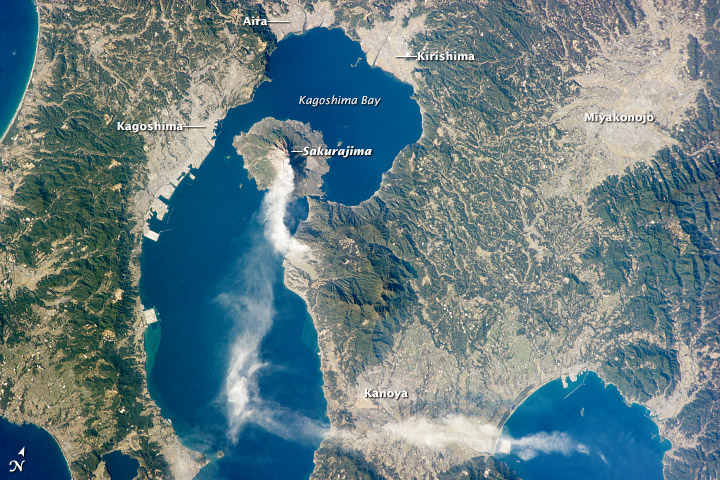Japan’s Sakurajima volcano
February 8th, 2016
This photograph, taken from the International Space Station, highlights one of Japan’s most active volcanoes. Sakurajima began forming approximately 13,000 years ago; prior to 1914, it was an island in Kagoshima Bay. Sakurajima was joined to the mainland by the deposition of volcanic material following a major eruption in 1914.
Several craters lie near the 1,117-meter summit of Sakurajima. The northernmost crater, Kita-dake, last erupted approximately 5,000 years ago; to the south, Minami-dake and Showa craters have been the site of frequent eruptions since at least the eighth century. The ash plume visible near the volcano’s summit may have originated from either Minami-dake or Showa.
This image highlights the proximity of several large urban areas—Aira, Kagoshima, Kanoya, Kirishima, and Miyakonojo—to Sakurajima. This has prompted studies of potential health hazards presented by the volcanic ash (such as Hillman et al. 2012), and those findings are particularly important if more powerful explosive eruptive activity resumes. The Tokyo Volcanic Ash Advisory Center (VAAC) of the Japan Meteorological Agency issues advisories when eruptions occur. An advisory on the activity in this image was issued less than one hour before the astronaut took the photograph, by which time the plume tail had encountered northeast-trending upper-level winds.
-
Reference
- Hillman, S.E., Horwell, C.J., Densmore, A.L., Damby, D.E., Fubini, B., Ishimine, Y., and Tomatis, M. (2012) Sakurajima volcano: a physico-chemical study of the health consequences of long-term exposure to volcanic ash. Bulletin of Volcanology, 74:913–930.

